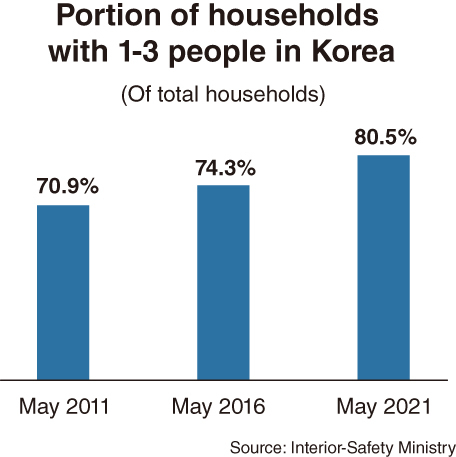[News Focus] Korean households getting smaller: 4 in 5 have fewer than four members
By Kim Yon-sePublished : June 14, 2021 - 16:35

SEJONG -- The proportion of households in South Korea with fewer than four members has reached an all-time high, government data showed.
According to the Ministry of Interior and Safety, the numbers of one-, two- and three-member households came to 9.21 million, 5.49 million and 4 million, respectively, in May.
Collectively, these 18.71 million households made up 80.5 percent of the nationwide total, which was 22.22 million. This means only 1 out of every 5 households had four or more members.
In contrast, households with fewer than four members made up 74.3 percent of the total five years earlier in May 2016 and 70.9 percent a decade earlier, in May 2011.
This is mainly attributable to a surge in the tally of single-person households, which marked a record high of 9.21 million last month and made up 39.6 percent of all households.

Ministry data showed that two-member households first overtook four-member households in number in November 2013, meeting at 4.13 million each.
Three-member households overtook four-member households in February 2017, when the respective numbers were 3.93 million and 3.92 million.
A demographic researcher in Sejong said the number of Koreans living alone had increased briskly, as had the number of couples without children.
“This reflects the social trend that the percentage of people in their 70s or over increased sharply,” he said, pointing out that this trend accompanied the world’s lowest fertility rates as well as a trend toward fewer marriages.
The number of people aged 70 or over came to 5.73 million as of May, accounting for 11 percent of the population. Adults aged 65 or over made up 16.7 percent of the population (8.63 million people).
The nation’s fertility rate marked an all-time low of 0.84 in 2020, according to Statistics Korea -- the lowest among all 37 members of the Organization for Economic Cooperation and Development, and estimated to be the lowest in the world.
By region, Seoul surpassed the nationwide average (39.6 percent) in the proportion of single-member households. Of the 4.4 million households in the capital last month, 42.2 percent (1.86 million) consisted of people living alone.
Considering that the figure stood at 36.3 percent in March 2011, the number of single-person households in Seoul relative to the total recorded 5.9 percentage point growth over a decade. This is ascribable to the presence of many young, unmarried people in their 20s and 30s working or studying in the capital amid low marriage and fertility rates.
Meanwhile, a growing number of older adults are residing alone in rural areas in the nation’s nine provinces after losing a spouse, with their married children having moved to metropolitan cities.
Some private researchers argue that policymakers lack countermeasures for an aging society in which a rapidly growing number of older people live alone.
Korea is no longer an aging society, in which people aged 65 or over comprise at least 7 percent of the total. Instead it is an aged society by UN standards, meaning 14 percent or more of the population is over 65. Furthermore, it is heading toward superaged society status, with 20 percent or more of its people over age 65.
Korea has seen the average age of its population rise by five years over the past decade -- from 38.4 years in May 2011 to 43.4 years (42.3 for men and 44.5 for women) in May 2021.
By Kim Yon-se (kys@heraldcorp.com)




![[Herald Interview] 'Amid aging population, Korea to invite more young professionals from overseas'](http://res.heraldm.com/phpwas/restmb_idxmake.php?idx=644&simg=/content/image/2024/04/24/20240424050844_0.jpg&u=20240424200058)












![[KH Explains] Korean shipbuilding stocks rally: Real growth or bubble?](http://res.heraldm.com/phpwas/restmb_idxmake.php?idx=652&simg=/content/image/2024/04/25/20240425050656_0.jpg&u=)

